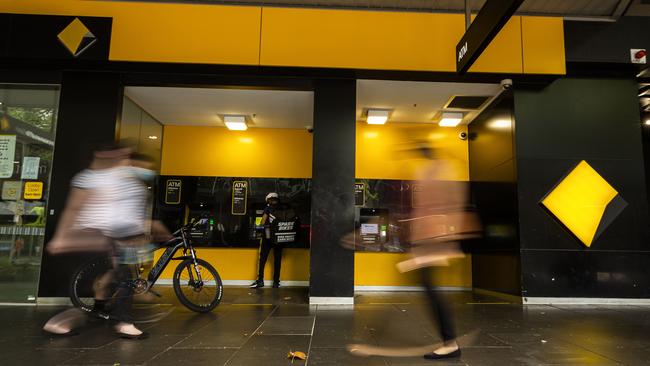CBA stakes out its BNPL territory
Matt Comyn says CBA will target Afterpay by becoming one of the largest and lowest-cost sources of leads in the buy now, pay later sector.

Commonwealth Bank has staked out its territory in the battle with buy now, pay later industry leader Afterpay, saying it expects to become one of the largest and lowest-cost sources of leads for business customers and merchants.
At a technology and investor day on Thursday, chief executive Matt Comyn clarified his ambitions for the bank’s multi-layered approach to hotly contested BNPL sector.
The bank’s direct offering, where customers will pay for their purchases in four equal instalments through the soon-to-be-launched StepPay digital-only card, reflected the importance of shopping to younger demographics.
“And when you talk to businesses, clearly they’re very conscious of the cost of buy now, pay later, and we’re now offering a quarter of that price,” Mr Comyn said.
“But of course they’re also interested in the volume of sales or leads which can be generated, and we can uniquely bring together our retail and business customers to deliver a very high volume of low-cost leads to our businesses.
“We think if you bring those pieces together it’s a very compelling proposition, and certainly we hope it will compare favourably to any existing offers in the market.”
The strategy, he said, would be facilitated by the bank’s recent purchase of a 23 per cent stake in Little Birdie - an online shopping start-up to help customers find special deals online.
Little Birdie, which has about 70m products to search, is driven by artificial intelligence, enabling customers to find best offers, get price-drop notifications and learn about the latest sale events.
CBA has also bought a 5 per cent stake in global BNPL Klarna, and struck a 50:50 partnership deal for the platform’s rollout in Australasia, which has now exceeded 850,000 downloads.
It launched in New Zealand a month ago.
The bank’s dual-pronged approach seeks to attack Afterpay where it’s considered most vulnerable - relatively high merchant fees.
Afterpay has said its merchant customers are happy to pay the fees because of the high-quality sales leads they get from the BNPL giant.
CBA’s digital presentation attracted some early criticism from Evans & Partners analyst Matthew Wilson, who said it amounted to applying some “digital lipstick” to the nation’s largest bank.
Mr Wilson later updated his assessment, saying the update was “digital glue” designed to stave off disrupters.
“The challenge for large incumbent banks is the emergence of new monoline technology offerings (Athena and Nano) plus viral platforms (Afterpay) that fundamentally change the unit economics, the returns, the user experience and the nature of retail banking - more mobile, more social, more analytical and a more demanding, broader offer,” he said. “Legacy providers of retail banking could be fighting a path to obsolescence or at best are transitioning from a once valuable service offering to a utility/credit factory.
“CBA‘s approach appears to partly echo the search for ‘tomorrow’s bank’ that has taken place in Israel with, for example, the emergence of Pepper by Bank Leumi. But what will a central bank digital currency ultimately mean?”
CBA also flagged at the presentation that it would become the first of the major banks to allow customers to view account balances from other financial institutions directly in the CommBank app, under the consumer data right.
Mr Comyn said the strategy was to integrate new services into the bank’s platform to customise and bring more value to customers.
“It’s about moving beyond customer service and delivering more rewarding experiences and better outcomes that will build a deeper, more trusted relationship with our customers,” he said.
The CBA chief unveiled several minority equity stakes - worth a total of $50m - in disruptive companies.
Apart from Little Birdie, there was a 25 per cent shareholding in Amber, which provides subscription-based access to wholesale electricity prices.
The purpose of the Amber partnership was to differentiate CBA’s home-buying proposition, with Amber providing direct access to wholesale prices and bringing additional discounts for CBA customers.
Mr Comyn foreshadowed increasing benefits to consumers as the consumer data right was extended to energy and other sectors.
“Combined with our 50:50 partnership with Klarna in Australia and StepPay, we have a highly differentiated platform to help business customers grow and retail customers save money,” he said.
CBA, he said, was not intent on transforming itself into a tech company which also happened to be good at banking.
“We’re very much a bank,” he said.
Technology was increasingly important and had been central to CBA’s strategy for 20 years, and financial institutions with the capacity to invest and pursue a differentiated strategy were “going to win over the long term”.
“Clearly that very much starts with the customer proposition,” Mr Comy said.
“So there are elements of technology that we look to, particularly around the pace and some of the engineering approaches.
“But we’re very much grounded in our core business; we just see technology as a huge enabler and I think a powerful point of differentiation versus many other institutions.”


